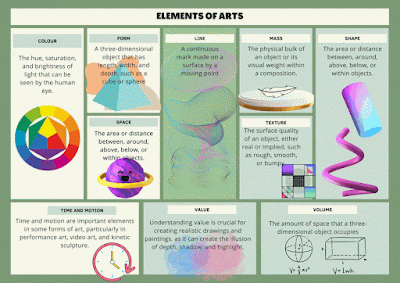10 Elements of Art for Every Visual Arts Student: Exploring the Essentials
Certainly!
10 essential elements of art
Line:
Straight lines can create a sense of stability and order in a composition, while curved lines can create a sense of movement and energy.
Examples:
The straight lines in Piet Mondrian's "Composition II in Red, Blue, and Yellow" create a sense of structure and balance, while the curved lines in Vincent van Gogh's "Starry Night" create a sense of movement and fluidity.
 |
| Piet Mondrian's "Composition II in Red, Blue, and Yellow |
Shape:
Geometric shapes such as squares, circles, and triangles can create a sense of order and precision, while organic shapes such as leaves or clouds can create a sense of nature and spontaneity.
Examples:
The geometric shapes in Kazimir Malevich's "Black Square" create a sense of simplicity and abstraction, while the organic shapes in Henri Matisse's "The Dance" create a sense of fluidity and motion.
 |
| Kazimir Malevich's "Black Square" |
 |
| Henri Matisse's "The Dance" |
Form:
Forms can be used to create depth and volume in a composition, and can suggest a sense of solidity or weight.
Examples:
The three-dimensional forms in Michelangelo's "David" create a sense of weight and solidity, while the forms in Claes Oldenburg's "Soft Toilet" create a sense of playfulness and whimsy.
 |
| Michelangelo's "David" |
 |
| Claes Oldenburg's "Soft Toilet |
Space:
Positive space refers to the area occupied by objects in a composition, while negative space refers to the area around and between objects. The use of space can create a sense of depth, perspective, and atmosphere in a composition.
Examples:
The use of negative space in René Magritte's "The Treachery of Images" creates a sense of mystery and illusion, while the use of space in Edward Hopper's "Nighthawks" creates a sense of isolation and loneliness.
 |
| René Magritte's "The Treachery of Images |
click here to buy poster ofrene magrittes
 |
| Edward Hopper's "Nighthawks" |
Texture:
Texture can be used to create contrast, depth, and visual interest in a composition. It can be created through the use of different materials, such as paint, clay, or fabric.
Examples:
The texture in Vincent van Gogh's "The Potato Eaters" creates a sense of roughness and poverty, while the texture in Gustav Klimt's "The Kiss" creates a sense of richness and luxury.
 |
| Vincent van Gogh's "The Potato Eaters" |
 |
| Gustav Klimt's "The Kiss" |
Value:
Value refers to the lightness or darkness of an object, and can be used to create contrast, depth, and mood in a composition.
Examples:
The use of high contrast in Rembrandt's "The Night Watch" creates a sense of drama and tension, while the use of low contrast in Johannes Vermeer's "Girl with a Pearl Earring" creates a sense of serenity and beauty.
 |
| Rembrandt's "The Night Watch" |
 |
| Johannes Vermeer's "Girl with a Pearl Earring |
Color:
Color is one of the most important elements of art, and can be used to express emotion, create mood, and draw attention to certain areas of a composition.
Examples:
The use of warm colors in Vincent van Gogh's "Sunflowers" creates a sense of joy and energy, while the use of cool colors in Pablo Picasso's "Blue Nude" creates a sense of sadness and melancholy.
 |
| Vincent van Gogh's "Sunflowers" |
 |
| Pablo Picasso's "Blue Nude" |
Mass:
Mass refers to the physical bulk of an object, and can be used to create weight, volume, and solidity in a composition.
Examples:
The sense of mass in Auguste Rodin's "The Thinker" creates a sense of intellectual power and intensity, while the mass in Jeff Koons' "Balloon Dog" creates a sense of playfulness and humor.
 |
| Auguste Rodin's "The Thinker" Jeff Koons' "Balloon Dog" |
Time and Motion:
Time and motion can be used to create a sense of action, rhythm, and energy in a composition.
Examples:
The use of motion in Marcel Duchamp's "Nude Descending a Staircase" uses motion to create a sense of movement and change, while Georges Seurat's "A Sunday on La Grande Jatte" uses time to create a sense of leisure and relaxation.
 |
| Marcel Duchamp's "Nude Descending a Staircase" |
 |
| Georges Seurat's "A Sunday on La Grande Jatte" |
Volume:
Volume refers to the amount of space that an object occupies and can create a sense of depth, weight, and presence.
Example:
Pablo Picasso's "Les Demoiselles d'Avignon" uses volume to create a sense of power and intensity.
 |
| Pablo Picasso's "Les Demoiselles d'Avignon" |









0 comments